Report on Ethical Behavior, Corporate Governance at Sainsbury's
VerifiedAdded on 2021/01/02
|17
|5227
|384
Report
AI Summary
This report provides a detailed analysis of ethical behavior and corporate governance within Sainsbury's, a major UK supermarket chain. It examines the application of laws and practices affecting corporate behavior and financial reporting, considering both national and international perspectives. The report explores the roles of professional institutes, principal approaches to governance, and associated risks, including corporate strategy and executive compensation. It identifies key stakeholders such as investors, suppliers, government, and shareholders, and assesses the impact of financial reporting on each. Furthermore, it highlights the significance of corporate governance and ethical behavior, evaluating ethical issues like agency problems and environmental concerns. Solutions to these issues, such as employee training and assigning responsibility, are also discussed. The report then delves into the regulatory framework, accounting information, and accounting concepts and theories, assessing the impact of regulations on the business, and evaluating specific accounting practices and policies. The conclusion summarizes the key findings and recommendations for enhancing ethical conduct and corporate governance within the organization.
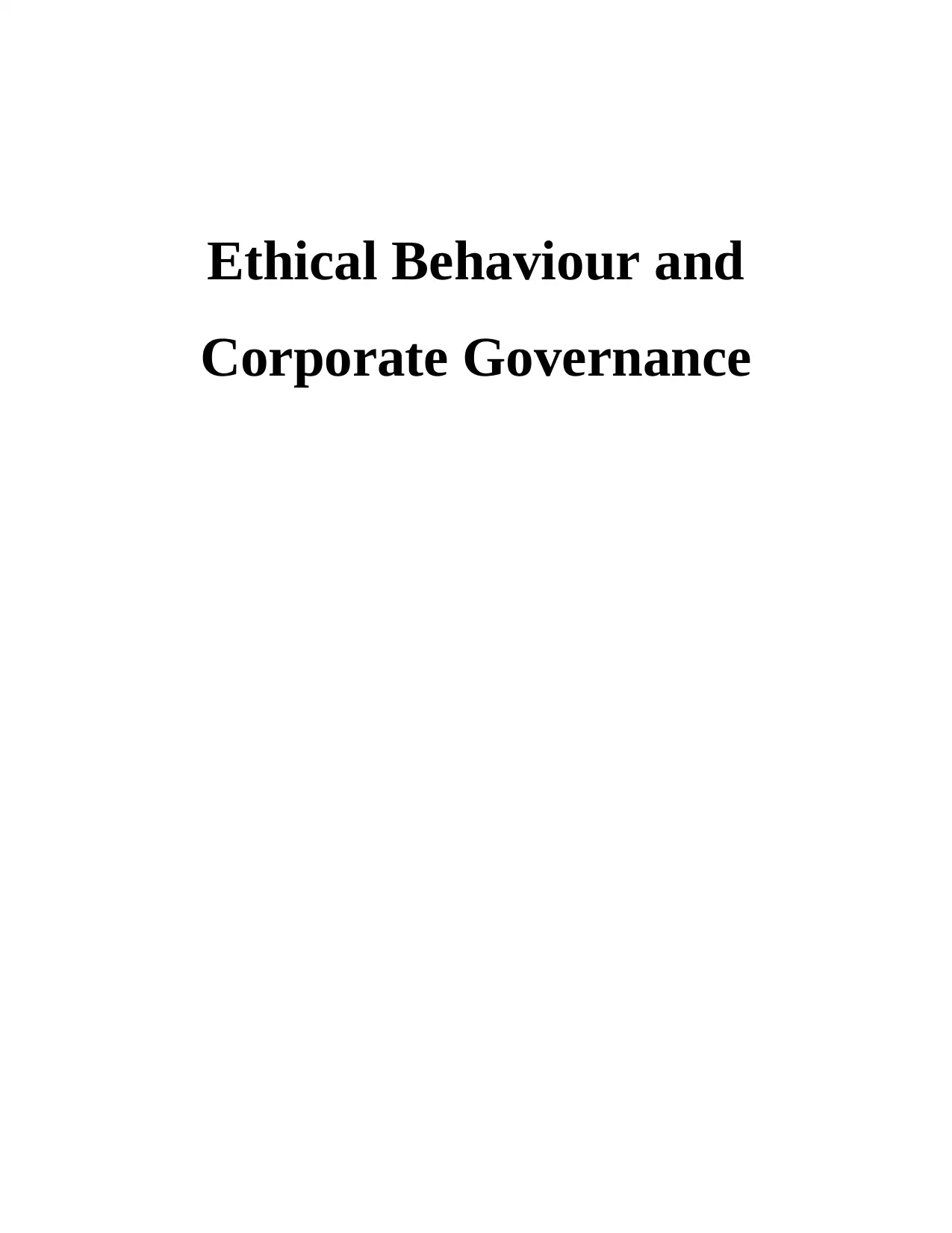
Ethical Behaviour and
Corporate Governance
Corporate Governance
Paraphrase This Document
Need a fresh take? Get an instant paraphrase of this document with our AI Paraphraser
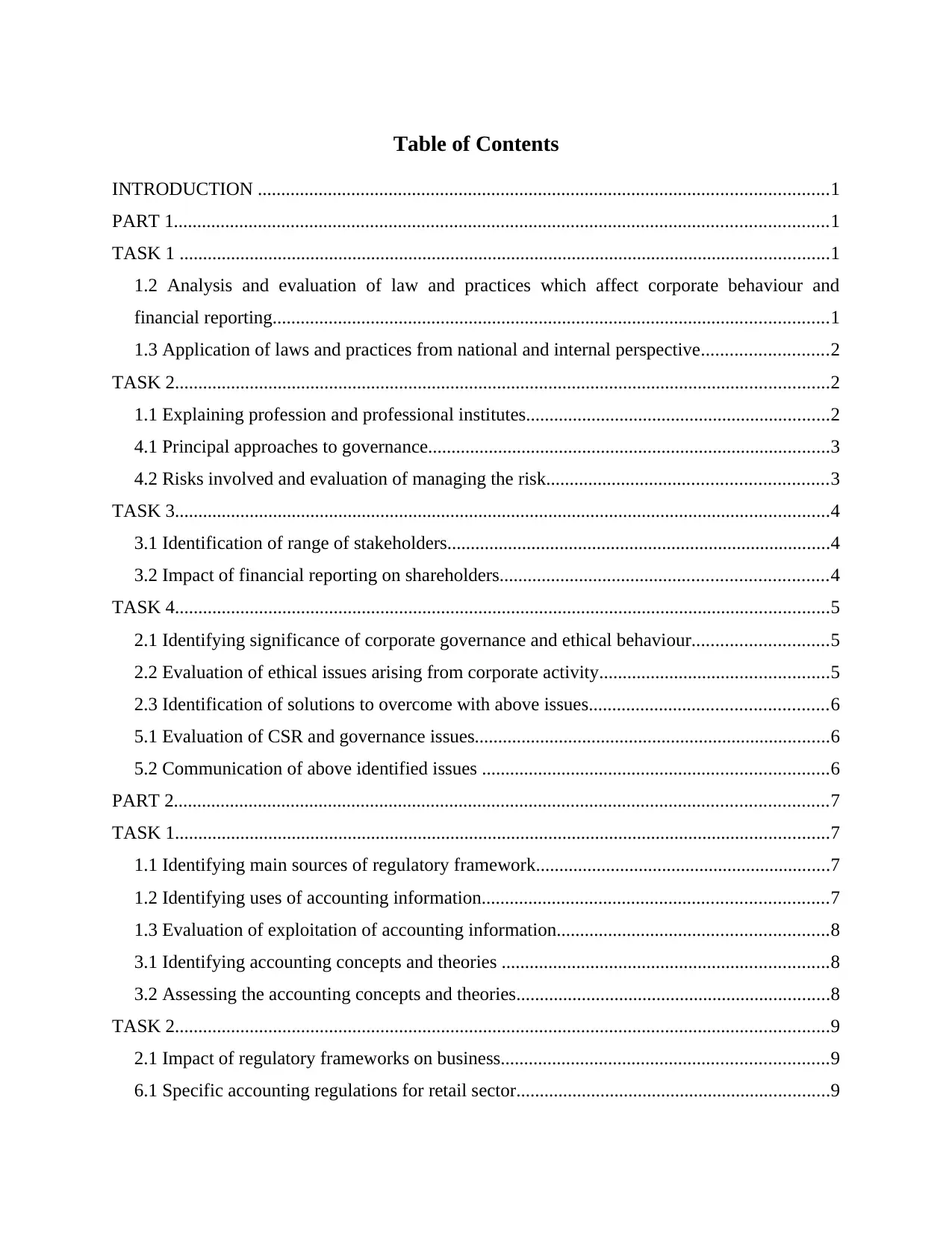
Table of Contents
INTRODUCTION ..........................................................................................................................1
PART 1............................................................................................................................................1
TASK 1 ...........................................................................................................................................1
1.2 Analysis and evaluation of law and practices which affect corporate behaviour and
financial reporting.......................................................................................................................1
1.3 Application of laws and practices from national and internal perspective...........................2
TASK 2............................................................................................................................................2
1.1 Explaining profession and professional institutes.................................................................2
4.1 Principal approaches to governance......................................................................................3
4.2 Risks involved and evaluation of managing the risk............................................................3
TASK 3............................................................................................................................................4
3.1 Identification of range of stakeholders..................................................................................4
3.2 Impact of financial reporting on shareholders......................................................................4
TASK 4............................................................................................................................................5
2.1 Identifying significance of corporate governance and ethical behaviour.............................5
2.2 Evaluation of ethical issues arising from corporate activity.................................................5
2.3 Identification of solutions to overcome with above issues...................................................6
5.1 Evaluation of CSR and governance issues............................................................................6
5.2 Communication of above identified issues ..........................................................................6
PART 2............................................................................................................................................7
TASK 1............................................................................................................................................7
1.1 Identifying main sources of regulatory framework...............................................................7
1.2 Identifying uses of accounting information..........................................................................7
1.3 Evaluation of exploitation of accounting information..........................................................8
3.1 Identifying accounting concepts and theories ......................................................................8
3.2 Assessing the accounting concepts and theories...................................................................8
TASK 2............................................................................................................................................9
2.1 Impact of regulatory frameworks on business......................................................................9
6.1 Specific accounting regulations for retail sector...................................................................9
INTRODUCTION ..........................................................................................................................1
PART 1............................................................................................................................................1
TASK 1 ...........................................................................................................................................1
1.2 Analysis and evaluation of law and practices which affect corporate behaviour and
financial reporting.......................................................................................................................1
1.3 Application of laws and practices from national and internal perspective...........................2
TASK 2............................................................................................................................................2
1.1 Explaining profession and professional institutes.................................................................2
4.1 Principal approaches to governance......................................................................................3
4.2 Risks involved and evaluation of managing the risk............................................................3
TASK 3............................................................................................................................................4
3.1 Identification of range of stakeholders..................................................................................4
3.2 Impact of financial reporting on shareholders......................................................................4
TASK 4............................................................................................................................................5
2.1 Identifying significance of corporate governance and ethical behaviour.............................5
2.2 Evaluation of ethical issues arising from corporate activity.................................................5
2.3 Identification of solutions to overcome with above issues...................................................6
5.1 Evaluation of CSR and governance issues............................................................................6
5.2 Communication of above identified issues ..........................................................................6
PART 2............................................................................................................................................7
TASK 1............................................................................................................................................7
1.1 Identifying main sources of regulatory framework...............................................................7
1.2 Identifying uses of accounting information..........................................................................7
1.3 Evaluation of exploitation of accounting information..........................................................8
3.1 Identifying accounting concepts and theories ......................................................................8
3.2 Assessing the accounting concepts and theories...................................................................8
TASK 2............................................................................................................................................9
2.1 Impact of regulatory frameworks on business......................................................................9
6.1 Specific accounting regulations for retail sector...................................................................9
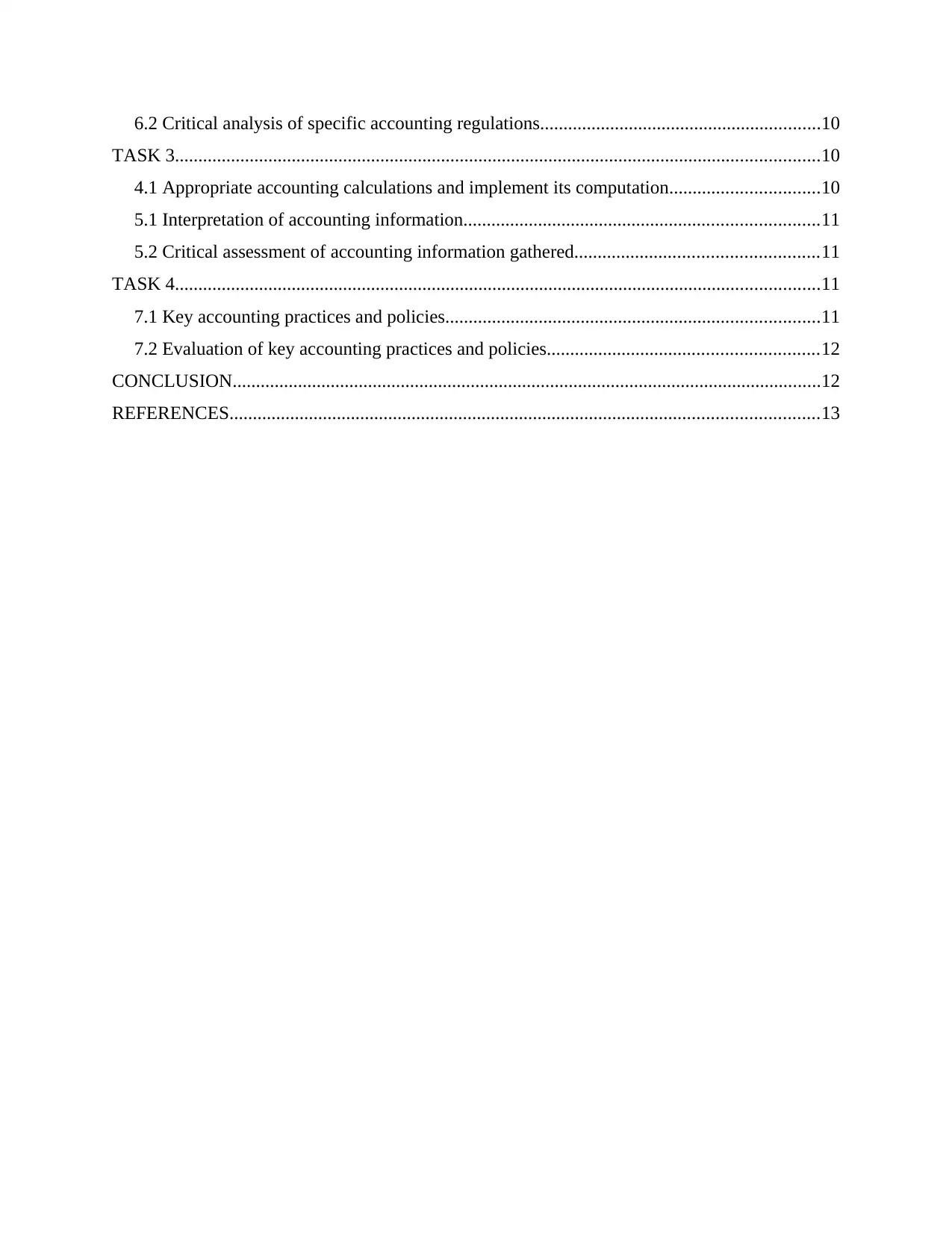
6.2 Critical analysis of specific accounting regulations............................................................10
TASK 3..........................................................................................................................................10
4.1 Appropriate accounting calculations and implement its computation................................10
5.1 Interpretation of accounting information............................................................................11
5.2 Critical assessment of accounting information gathered....................................................11
TASK 4..........................................................................................................................................11
7.1 Key accounting practices and policies................................................................................11
7.2 Evaluation of key accounting practices and policies..........................................................12
CONCLUSION..............................................................................................................................12
REFERENCES..............................................................................................................................13
TASK 3..........................................................................................................................................10
4.1 Appropriate accounting calculations and implement its computation................................10
5.1 Interpretation of accounting information............................................................................11
5.2 Critical assessment of accounting information gathered....................................................11
TASK 4..........................................................................................................................................11
7.1 Key accounting practices and policies................................................................................11
7.2 Evaluation of key accounting practices and policies..........................................................12
CONCLUSION..............................................................................................................................12
REFERENCES..............................................................................................................................13
⊘ This is a preview!⊘
Do you want full access?
Subscribe today to unlock all pages.

Trusted by 1+ million students worldwide
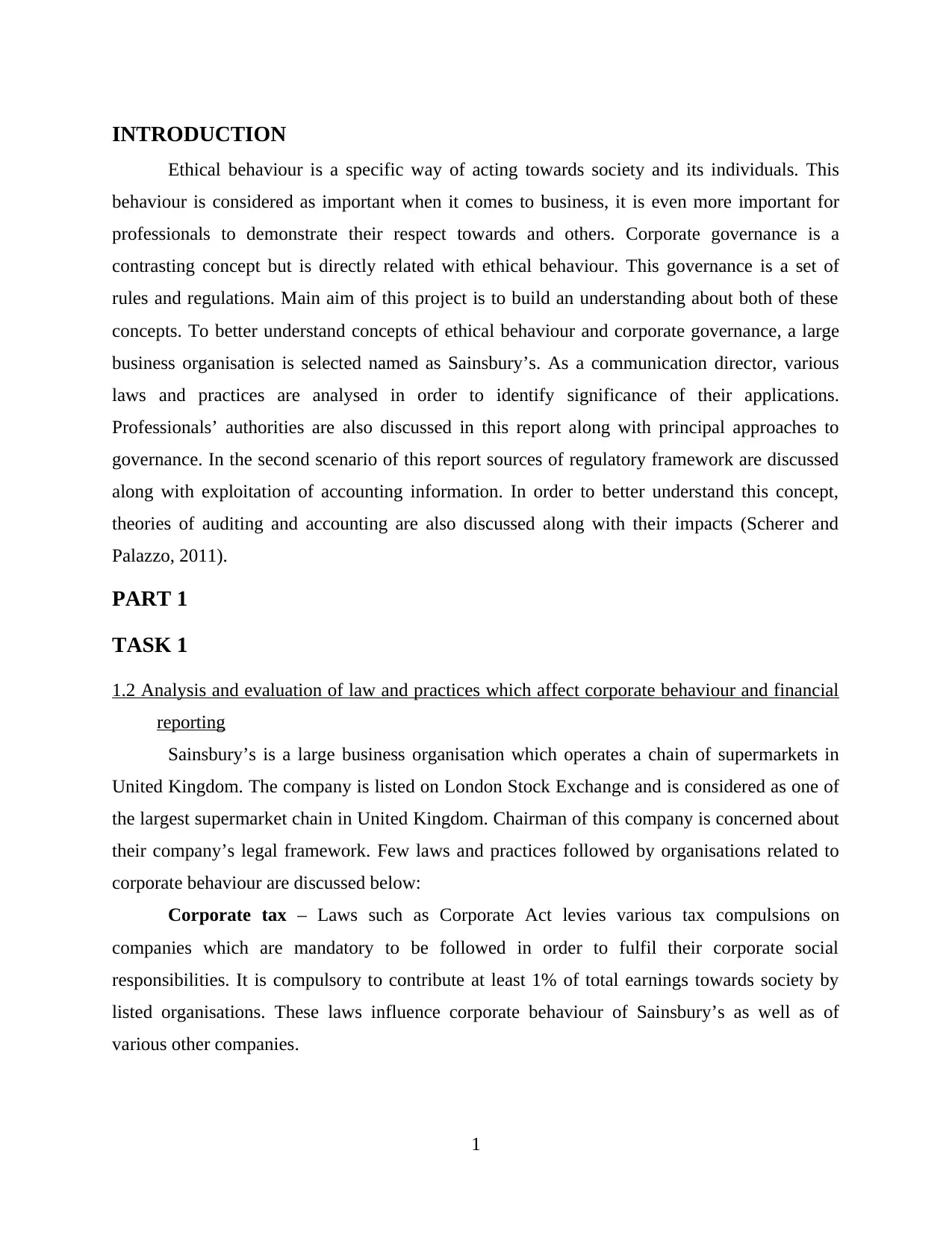
INTRODUCTION
Ethical behaviour is a specific way of acting towards society and its individuals. This
behaviour is considered as important when it comes to business, it is even more important for
professionals to demonstrate their respect towards and others. Corporate governance is a
contrasting concept but is directly related with ethical behaviour. This governance is a set of
rules and regulations. Main aim of this project is to build an understanding about both of these
concepts. To better understand concepts of ethical behaviour and corporate governance, a large
business organisation is selected named as Sainsbury’s. As a communication director, various
laws and practices are analysed in order to identify significance of their applications.
Professionals’ authorities are also discussed in this report along with principal approaches to
governance. In the second scenario of this report sources of regulatory framework are discussed
along with exploitation of accounting information. In order to better understand this concept,
theories of auditing and accounting are also discussed along with their impacts (Scherer and
Palazzo, 2011).
PART 1
TASK 1
1.2 Analysis and evaluation of law and practices which affect corporate behaviour and financial
reporting
Sainsbury’s is a large business organisation which operates a chain of supermarkets in
United Kingdom. The company is listed on London Stock Exchange and is considered as one of
the largest supermarket chain in United Kingdom. Chairman of this company is concerned about
their company’s legal framework. Few laws and practices followed by organisations related to
corporate behaviour are discussed below:
Corporate tax – Laws such as Corporate Act levies various tax compulsions on
companies which are mandatory to be followed in order to fulfil their corporate social
responsibilities. It is compulsory to contribute at least 1% of total earnings towards society by
listed organisations. These laws influence corporate behaviour of Sainsbury’s as well as of
various other companies.
1
Ethical behaviour is a specific way of acting towards society and its individuals. This
behaviour is considered as important when it comes to business, it is even more important for
professionals to demonstrate their respect towards and others. Corporate governance is a
contrasting concept but is directly related with ethical behaviour. This governance is a set of
rules and regulations. Main aim of this project is to build an understanding about both of these
concepts. To better understand concepts of ethical behaviour and corporate governance, a large
business organisation is selected named as Sainsbury’s. As a communication director, various
laws and practices are analysed in order to identify significance of their applications.
Professionals’ authorities are also discussed in this report along with principal approaches to
governance. In the second scenario of this report sources of regulatory framework are discussed
along with exploitation of accounting information. In order to better understand this concept,
theories of auditing and accounting are also discussed along with their impacts (Scherer and
Palazzo, 2011).
PART 1
TASK 1
1.2 Analysis and evaluation of law and practices which affect corporate behaviour and financial
reporting
Sainsbury’s is a large business organisation which operates a chain of supermarkets in
United Kingdom. The company is listed on London Stock Exchange and is considered as one of
the largest supermarket chain in United Kingdom. Chairman of this company is concerned about
their company’s legal framework. Few laws and practices followed by organisations related to
corporate behaviour are discussed below:
Corporate tax – Laws such as Corporate Act levies various tax compulsions on
companies which are mandatory to be followed in order to fulfil their corporate social
responsibilities. It is compulsory to contribute at least 1% of total earnings towards society by
listed organisations. These laws influence corporate behaviour of Sainsbury’s as well as of
various other companies.
1
Paraphrase This Document
Need a fresh take? Get an instant paraphrase of this document with our AI Paraphraser
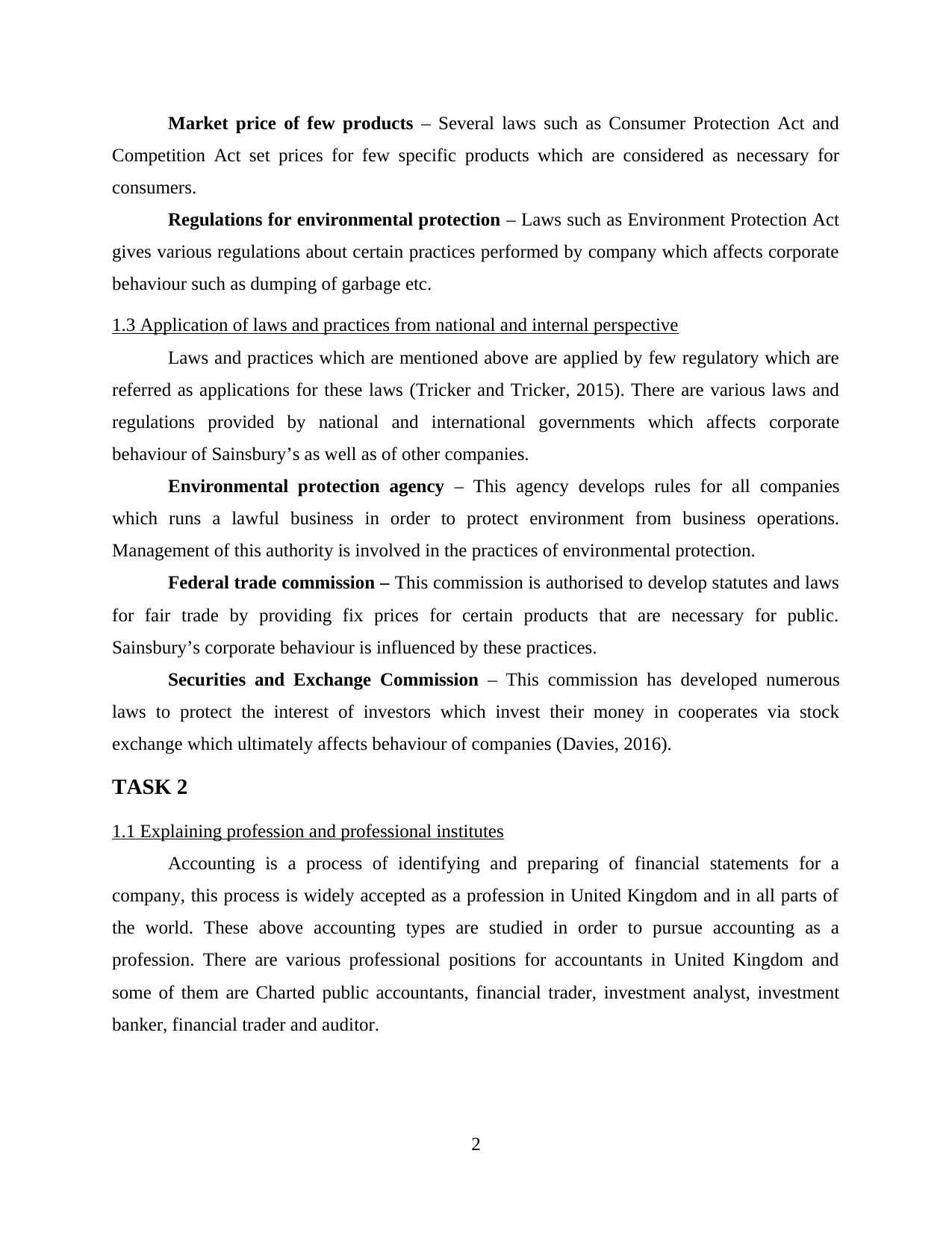
Market price of few products – Several laws such as Consumer Protection Act and
Competition Act set prices for few specific products which are considered as necessary for
consumers.
Regulations for environmental protection – Laws such as Environment Protection Act
gives various regulations about certain practices performed by company which affects corporate
behaviour such as dumping of garbage etc.
1.3 Application of laws and practices from national and internal perspective
Laws and practices which are mentioned above are applied by few regulatory which are
referred as applications for these laws (Tricker and Tricker, 2015). There are various laws and
regulations provided by national and international governments which affects corporate
behaviour of Sainsbury’s as well as of other companies.
Environmental protection agency – This agency develops rules for all companies
which runs a lawful business in order to protect environment from business operations.
Management of this authority is involved in the practices of environmental protection.
Federal trade commission – This commission is authorised to develop statutes and laws
for fair trade by providing fix prices for certain products that are necessary for public.
Sainsbury’s corporate behaviour is influenced by these practices.
Securities and Exchange Commission – This commission has developed numerous
laws to protect the interest of investors which invest their money in cooperates via stock
exchange which ultimately affects behaviour of companies (Davies, 2016).
TASK 2
1.1 Explaining profession and professional institutes
Accounting is a process of identifying and preparing of financial statements for a
company, this process is widely accepted as a profession in United Kingdom and in all parts of
the world. These above accounting types are studied in order to pursue accounting as a
profession. There are various professional positions for accountants in United Kingdom and
some of them are Charted public accountants, financial trader, investment analyst, investment
banker, financial trader and auditor.
2
Competition Act set prices for few specific products which are considered as necessary for
consumers.
Regulations for environmental protection – Laws such as Environment Protection Act
gives various regulations about certain practices performed by company which affects corporate
behaviour such as dumping of garbage etc.
1.3 Application of laws and practices from national and internal perspective
Laws and practices which are mentioned above are applied by few regulatory which are
referred as applications for these laws (Tricker and Tricker, 2015). There are various laws and
regulations provided by national and international governments which affects corporate
behaviour of Sainsbury’s as well as of other companies.
Environmental protection agency – This agency develops rules for all companies
which runs a lawful business in order to protect environment from business operations.
Management of this authority is involved in the practices of environmental protection.
Federal trade commission – This commission is authorised to develop statutes and laws
for fair trade by providing fix prices for certain products that are necessary for public.
Sainsbury’s corporate behaviour is influenced by these practices.
Securities and Exchange Commission – This commission has developed numerous
laws to protect the interest of investors which invest their money in cooperates via stock
exchange which ultimately affects behaviour of companies (Davies, 2016).
TASK 2
1.1 Explaining profession and professional institutes
Accounting is a process of identifying and preparing of financial statements for a
company, this process is widely accepted as a profession in United Kingdom and in all parts of
the world. These above accounting types are studied in order to pursue accounting as a
profession. There are various professional positions for accountants in United Kingdom and
some of them are Charted public accountants, financial trader, investment analyst, investment
banker, financial trader and auditor.
2
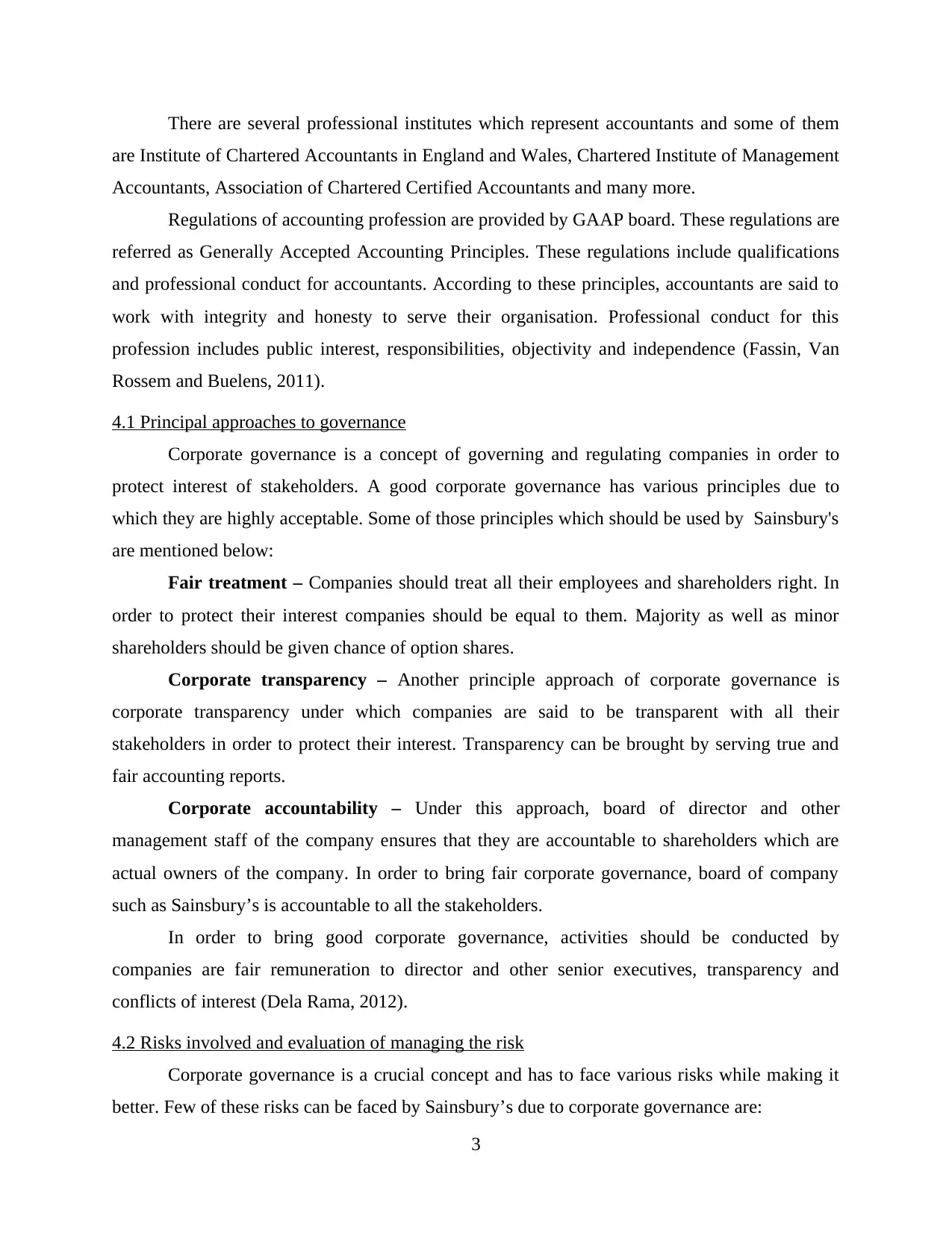
There are several professional institutes which represent accountants and some of them
are Institute of Chartered Accountants in England and Wales, Chartered Institute of Management
Accountants, Association of Chartered Certified Accountants and many more.
Regulations of accounting profession are provided by GAAP board. These regulations are
referred as Generally Accepted Accounting Principles. These regulations include qualifications
and professional conduct for accountants. According to these principles, accountants are said to
work with integrity and honesty to serve their organisation. Professional conduct for this
profession includes public interest, responsibilities, objectivity and independence (Fassin, Van
Rossem and Buelens, 2011).
4.1 Principal approaches to governance
Corporate governance is a concept of governing and regulating companies in order to
protect interest of stakeholders. A good corporate governance has various principles due to
which they are highly acceptable. Some of those principles which should be used by Sainsbury's
are mentioned below:
Fair treatment – Companies should treat all their employees and shareholders right. In
order to protect their interest companies should be equal to them. Majority as well as minor
shareholders should be given chance of option shares.
Corporate transparency – Another principle approach of corporate governance is
corporate transparency under which companies are said to be transparent with all their
stakeholders in order to protect their interest. Transparency can be brought by serving true and
fair accounting reports.
Corporate accountability – Under this approach, board of director and other
management staff of the company ensures that they are accountable to shareholders which are
actual owners of the company. In order to bring fair corporate governance, board of company
such as Sainsbury’s is accountable to all the stakeholders.
In order to bring good corporate governance, activities should be conducted by
companies are fair remuneration to director and other senior executives, transparency and
conflicts of interest (Dela Rama, 2012).
4.2 Risks involved and evaluation of managing the risk
Corporate governance is a crucial concept and has to face various risks while making it
better. Few of these risks can be faced by Sainsbury’s due to corporate governance are:
3
are Institute of Chartered Accountants in England and Wales, Chartered Institute of Management
Accountants, Association of Chartered Certified Accountants and many more.
Regulations of accounting profession are provided by GAAP board. These regulations are
referred as Generally Accepted Accounting Principles. These regulations include qualifications
and professional conduct for accountants. According to these principles, accountants are said to
work with integrity and honesty to serve their organisation. Professional conduct for this
profession includes public interest, responsibilities, objectivity and independence (Fassin, Van
Rossem and Buelens, 2011).
4.1 Principal approaches to governance
Corporate governance is a concept of governing and regulating companies in order to
protect interest of stakeholders. A good corporate governance has various principles due to
which they are highly acceptable. Some of those principles which should be used by Sainsbury's
are mentioned below:
Fair treatment – Companies should treat all their employees and shareholders right. In
order to protect their interest companies should be equal to them. Majority as well as minor
shareholders should be given chance of option shares.
Corporate transparency – Another principle approach of corporate governance is
corporate transparency under which companies are said to be transparent with all their
stakeholders in order to protect their interest. Transparency can be brought by serving true and
fair accounting reports.
Corporate accountability – Under this approach, board of director and other
management staff of the company ensures that they are accountable to shareholders which are
actual owners of the company. In order to bring fair corporate governance, board of company
such as Sainsbury’s is accountable to all the stakeholders.
In order to bring good corporate governance, activities should be conducted by
companies are fair remuneration to director and other senior executives, transparency and
conflicts of interest (Dela Rama, 2012).
4.2 Risks involved and evaluation of managing the risk
Corporate governance is a crucial concept and has to face various risks while making it
better. Few of these risks can be faced by Sainsbury’s due to corporate governance are:
3
⊘ This is a preview!⊘
Do you want full access?
Subscribe today to unlock all pages.

Trusted by 1+ million students worldwide
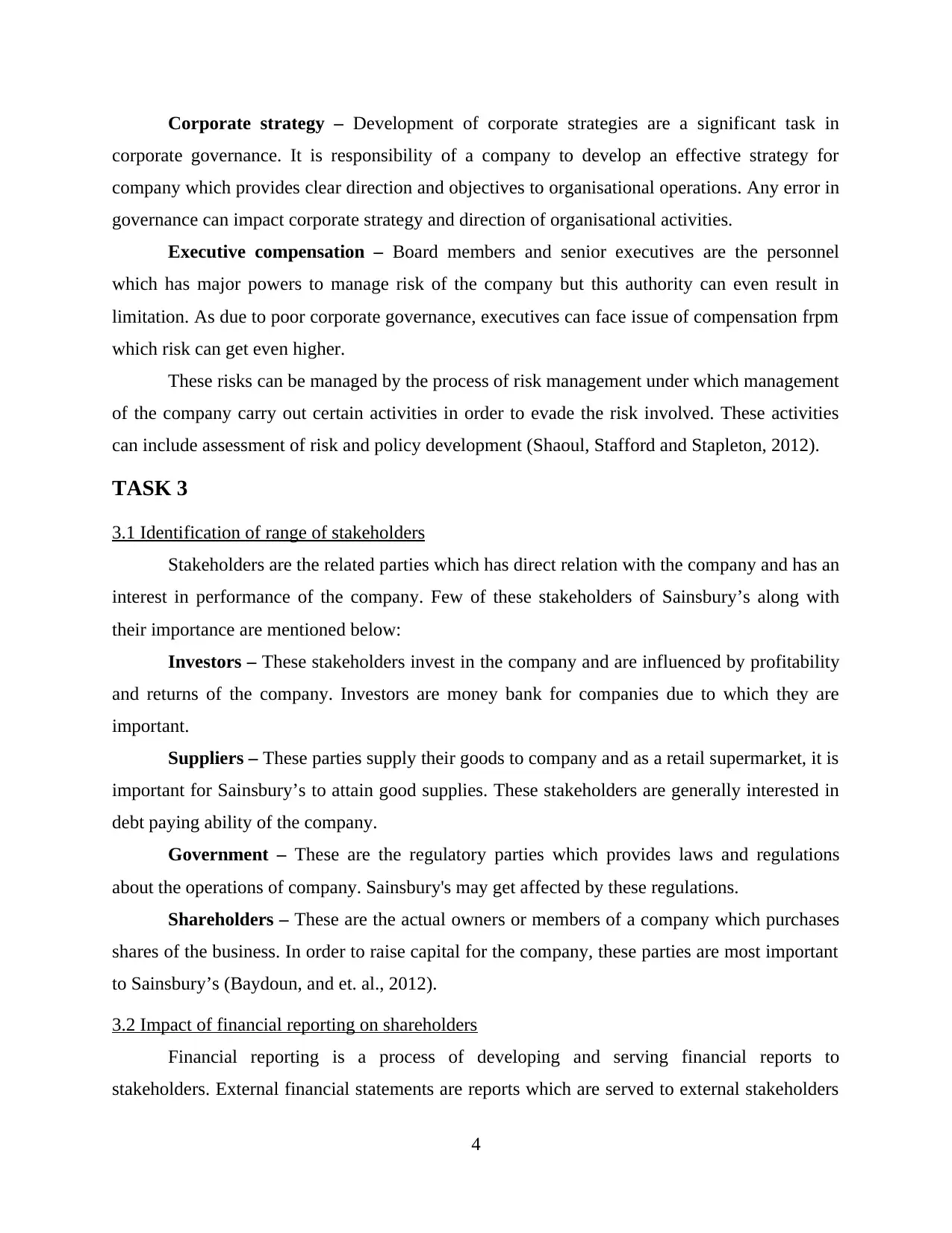
Corporate strategy – Development of corporate strategies are a significant task in
corporate governance. It is responsibility of a company to develop an effective strategy for
company which provides clear direction and objectives to organisational operations. Any error in
governance can impact corporate strategy and direction of organisational activities.
Executive compensation – Board members and senior executives are the personnel
which has major powers to manage risk of the company but this authority can even result in
limitation. As due to poor corporate governance, executives can face issue of compensation frpm
which risk can get even higher.
These risks can be managed by the process of risk management under which management
of the company carry out certain activities in order to evade the risk involved. These activities
can include assessment of risk and policy development (Shaoul, Stafford and Stapleton, 2012).
TASK 3
3.1 Identification of range of stakeholders
Stakeholders are the related parties which has direct relation with the company and has an
interest in performance of the company. Few of these stakeholders of Sainsbury’s along with
their importance are mentioned below:
Investors – These stakeholders invest in the company and are influenced by profitability
and returns of the company. Investors are money bank for companies due to which they are
important.
Suppliers – These parties supply their goods to company and as a retail supermarket, it is
important for Sainsbury’s to attain good supplies. These stakeholders are generally interested in
debt paying ability of the company.
Government – These are the regulatory parties which provides laws and regulations
about the operations of company. Sainsbury's may get affected by these regulations.
Shareholders – These are the actual owners or members of a company which purchases
shares of the business. In order to raise capital for the company, these parties are most important
to Sainsbury’s (Baydoun, and et. al., 2012).
3.2 Impact of financial reporting on shareholders
Financial reporting is a process of developing and serving financial reports to
stakeholders. External financial statements are reports which are served to external stakeholders
4
corporate governance. It is responsibility of a company to develop an effective strategy for
company which provides clear direction and objectives to organisational operations. Any error in
governance can impact corporate strategy and direction of organisational activities.
Executive compensation – Board members and senior executives are the personnel
which has major powers to manage risk of the company but this authority can even result in
limitation. As due to poor corporate governance, executives can face issue of compensation frpm
which risk can get even higher.
These risks can be managed by the process of risk management under which management
of the company carry out certain activities in order to evade the risk involved. These activities
can include assessment of risk and policy development (Shaoul, Stafford and Stapleton, 2012).
TASK 3
3.1 Identification of range of stakeholders
Stakeholders are the related parties which has direct relation with the company and has an
interest in performance of the company. Few of these stakeholders of Sainsbury’s along with
their importance are mentioned below:
Investors – These stakeholders invest in the company and are influenced by profitability
and returns of the company. Investors are money bank for companies due to which they are
important.
Suppliers – These parties supply their goods to company and as a retail supermarket, it is
important for Sainsbury’s to attain good supplies. These stakeholders are generally interested in
debt paying ability of the company.
Government – These are the regulatory parties which provides laws and regulations
about the operations of company. Sainsbury's may get affected by these regulations.
Shareholders – These are the actual owners or members of a company which purchases
shares of the business. In order to raise capital for the company, these parties are most important
to Sainsbury’s (Baydoun, and et. al., 2012).
3.2 Impact of financial reporting on shareholders
Financial reporting is a process of developing and serving financial reports to
stakeholders. External financial statements are reports which are served to external stakeholders
4
Paraphrase This Document
Need a fresh take? Get an instant paraphrase of this document with our AI Paraphraser
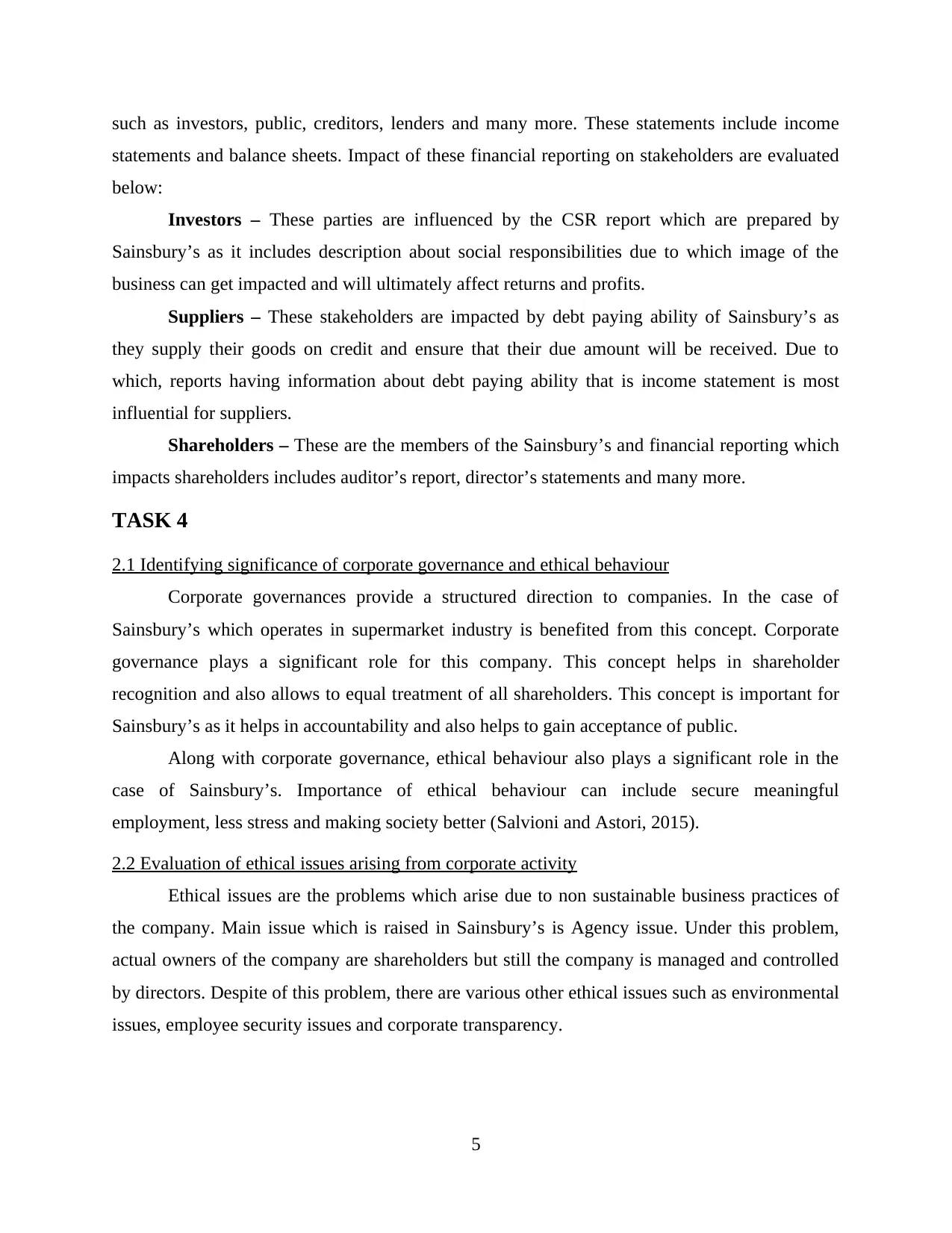
such as investors, public, creditors, lenders and many more. These statements include income
statements and balance sheets. Impact of these financial reporting on stakeholders are evaluated
below:
Investors – These parties are influenced by the CSR report which are prepared by
Sainsbury’s as it includes description about social responsibilities due to which image of the
business can get impacted and will ultimately affect returns and profits.
Suppliers – These stakeholders are impacted by debt paying ability of Sainsbury’s as
they supply their goods on credit and ensure that their due amount will be received. Due to
which, reports having information about debt paying ability that is income statement is most
influential for suppliers.
Shareholders – These are the members of the Sainsbury’s and financial reporting which
impacts shareholders includes auditor’s report, director’s statements and many more.
TASK 4
2.1 Identifying significance of corporate governance and ethical behaviour
Corporate governances provide a structured direction to companies. In the case of
Sainsbury’s which operates in supermarket industry is benefited from this concept. Corporate
governance plays a significant role for this company. This concept helps in shareholder
recognition and also allows to equal treatment of all shareholders. This concept is important for
Sainsbury’s as it helps in accountability and also helps to gain acceptance of public.
Along with corporate governance, ethical behaviour also plays a significant role in the
case of Sainsbury’s. Importance of ethical behaviour can include secure meaningful
employment, less stress and making society better (Salvioni and Astori, 2015).
2.2 Evaluation of ethical issues arising from corporate activity
Ethical issues are the problems which arise due to non sustainable business practices of
the company. Main issue which is raised in Sainsbury’s is Agency issue. Under this problem,
actual owners of the company are shareholders but still the company is managed and controlled
by directors. Despite of this problem, there are various other ethical issues such as environmental
issues, employee security issues and corporate transparency.
5
statements and balance sheets. Impact of these financial reporting on stakeholders are evaluated
below:
Investors – These parties are influenced by the CSR report which are prepared by
Sainsbury’s as it includes description about social responsibilities due to which image of the
business can get impacted and will ultimately affect returns and profits.
Suppliers – These stakeholders are impacted by debt paying ability of Sainsbury’s as
they supply their goods on credit and ensure that their due amount will be received. Due to
which, reports having information about debt paying ability that is income statement is most
influential for suppliers.
Shareholders – These are the members of the Sainsbury’s and financial reporting which
impacts shareholders includes auditor’s report, director’s statements and many more.
TASK 4
2.1 Identifying significance of corporate governance and ethical behaviour
Corporate governances provide a structured direction to companies. In the case of
Sainsbury’s which operates in supermarket industry is benefited from this concept. Corporate
governance plays a significant role for this company. This concept helps in shareholder
recognition and also allows to equal treatment of all shareholders. This concept is important for
Sainsbury’s as it helps in accountability and also helps to gain acceptance of public.
Along with corporate governance, ethical behaviour also plays a significant role in the
case of Sainsbury’s. Importance of ethical behaviour can include secure meaningful
employment, less stress and making society better (Salvioni and Astori, 2015).
2.2 Evaluation of ethical issues arising from corporate activity
Ethical issues are the problems which arise due to non sustainable business practices of
the company. Main issue which is raised in Sainsbury’s is Agency issue. Under this problem,
actual owners of the company are shareholders but still the company is managed and controlled
by directors. Despite of this problem, there are various other ethical issues such as environmental
issues, employee security issues and corporate transparency.
5
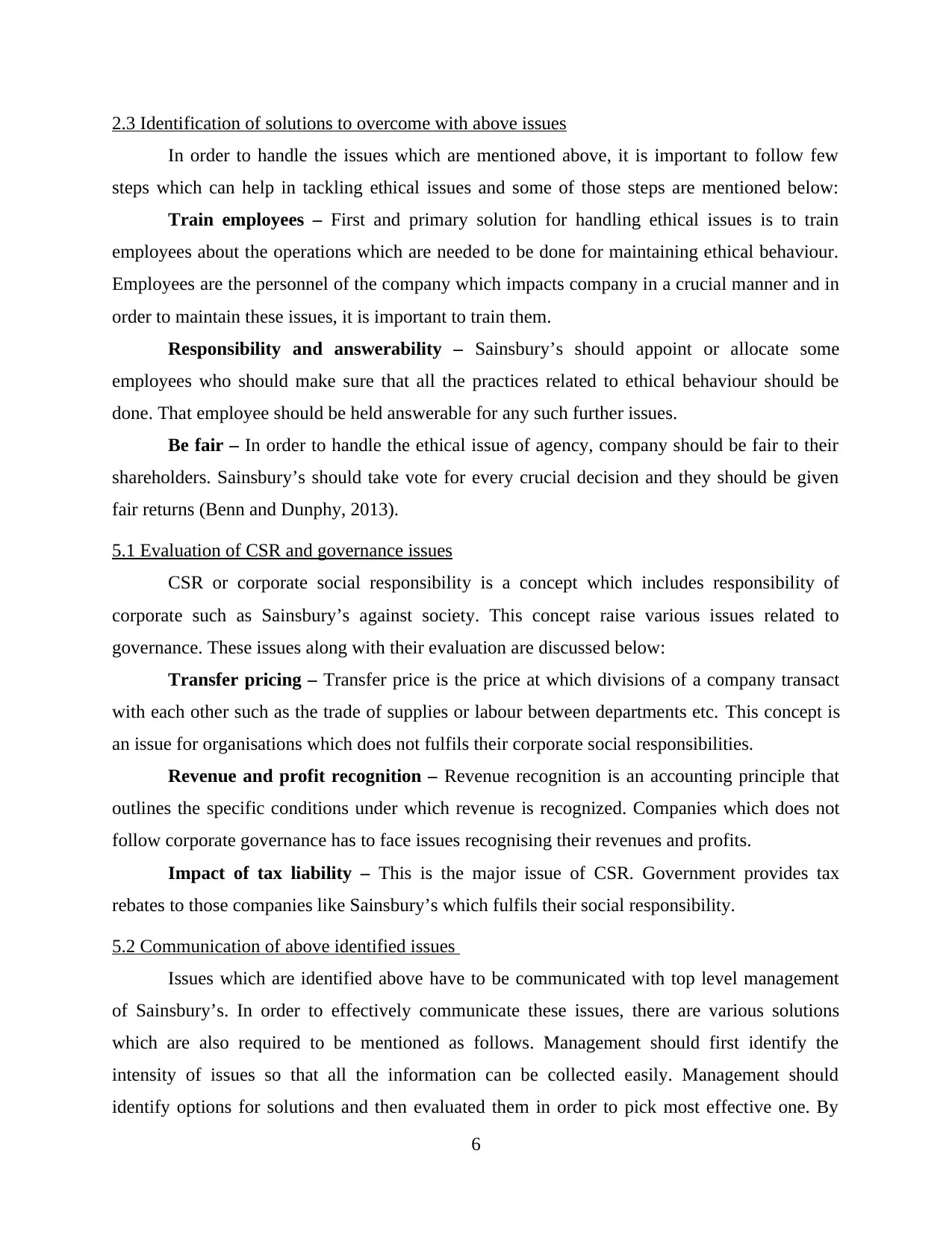
2.3 Identification of solutions to overcome with above issues
In order to handle the issues which are mentioned above, it is important to follow few
steps which can help in tackling ethical issues and some of those steps are mentioned below:
Train employees – First and primary solution for handling ethical issues is to train
employees about the operations which are needed to be done for maintaining ethical behaviour.
Employees are the personnel of the company which impacts company in a crucial manner and in
order to maintain these issues, it is important to train them.
Responsibility and answerability – Sainsbury’s should appoint or allocate some
employees who should make sure that all the practices related to ethical behaviour should be
done. That employee should be held answerable for any such further issues.
Be fair – In order to handle the ethical issue of agency, company should be fair to their
shareholders. Sainsbury’s should take vote for every crucial decision and they should be given
fair returns (Benn and Dunphy, 2013).
5.1 Evaluation of CSR and governance issues
CSR or corporate social responsibility is a concept which includes responsibility of
corporate such as Sainsbury’s against society. This concept raise various issues related to
governance. These issues along with their evaluation are discussed below:
Transfer pricing – Transfer price is the price at which divisions of a company transact
with each other such as the trade of supplies or labour between departments etc. This concept is
an issue for organisations which does not fulfils their corporate social responsibilities.
Revenue and profit recognition – Revenue recognition is an accounting principle that
outlines the specific conditions under which revenue is recognized. Companies which does not
follow corporate governance has to face issues recognising their revenues and profits.
Impact of tax liability – This is the major issue of CSR. Government provides tax
rebates to those companies like Sainsbury’s which fulfils their social responsibility.
5.2 Communication of above identified issues
Issues which are identified above have to be communicated with top level management
of Sainsbury’s. In order to effectively communicate these issues, there are various solutions
which are also required to be mentioned as follows. Management should first identify the
intensity of issues so that all the information can be collected easily. Management should
identify options for solutions and then evaluated them in order to pick most effective one. By
6
In order to handle the issues which are mentioned above, it is important to follow few
steps which can help in tackling ethical issues and some of those steps are mentioned below:
Train employees – First and primary solution for handling ethical issues is to train
employees about the operations which are needed to be done for maintaining ethical behaviour.
Employees are the personnel of the company which impacts company in a crucial manner and in
order to maintain these issues, it is important to train them.
Responsibility and answerability – Sainsbury’s should appoint or allocate some
employees who should make sure that all the practices related to ethical behaviour should be
done. That employee should be held answerable for any such further issues.
Be fair – In order to handle the ethical issue of agency, company should be fair to their
shareholders. Sainsbury’s should take vote for every crucial decision and they should be given
fair returns (Benn and Dunphy, 2013).
5.1 Evaluation of CSR and governance issues
CSR or corporate social responsibility is a concept which includes responsibility of
corporate such as Sainsbury’s against society. This concept raise various issues related to
governance. These issues along with their evaluation are discussed below:
Transfer pricing – Transfer price is the price at which divisions of a company transact
with each other such as the trade of supplies or labour between departments etc. This concept is
an issue for organisations which does not fulfils their corporate social responsibilities.
Revenue and profit recognition – Revenue recognition is an accounting principle that
outlines the specific conditions under which revenue is recognized. Companies which does not
follow corporate governance has to face issues recognising their revenues and profits.
Impact of tax liability – This is the major issue of CSR. Government provides tax
rebates to those companies like Sainsbury’s which fulfils their social responsibility.
5.2 Communication of above identified issues
Issues which are identified above have to be communicated with top level management
of Sainsbury’s. In order to effectively communicate these issues, there are various solutions
which are also required to be mentioned as follows. Management should first identify the
intensity of issues so that all the information can be collected easily. Management should
identify options for solutions and then evaluated them in order to pick most effective one. By
6
⊘ This is a preview!⊘
Do you want full access?
Subscribe today to unlock all pages.

Trusted by 1+ million students worldwide
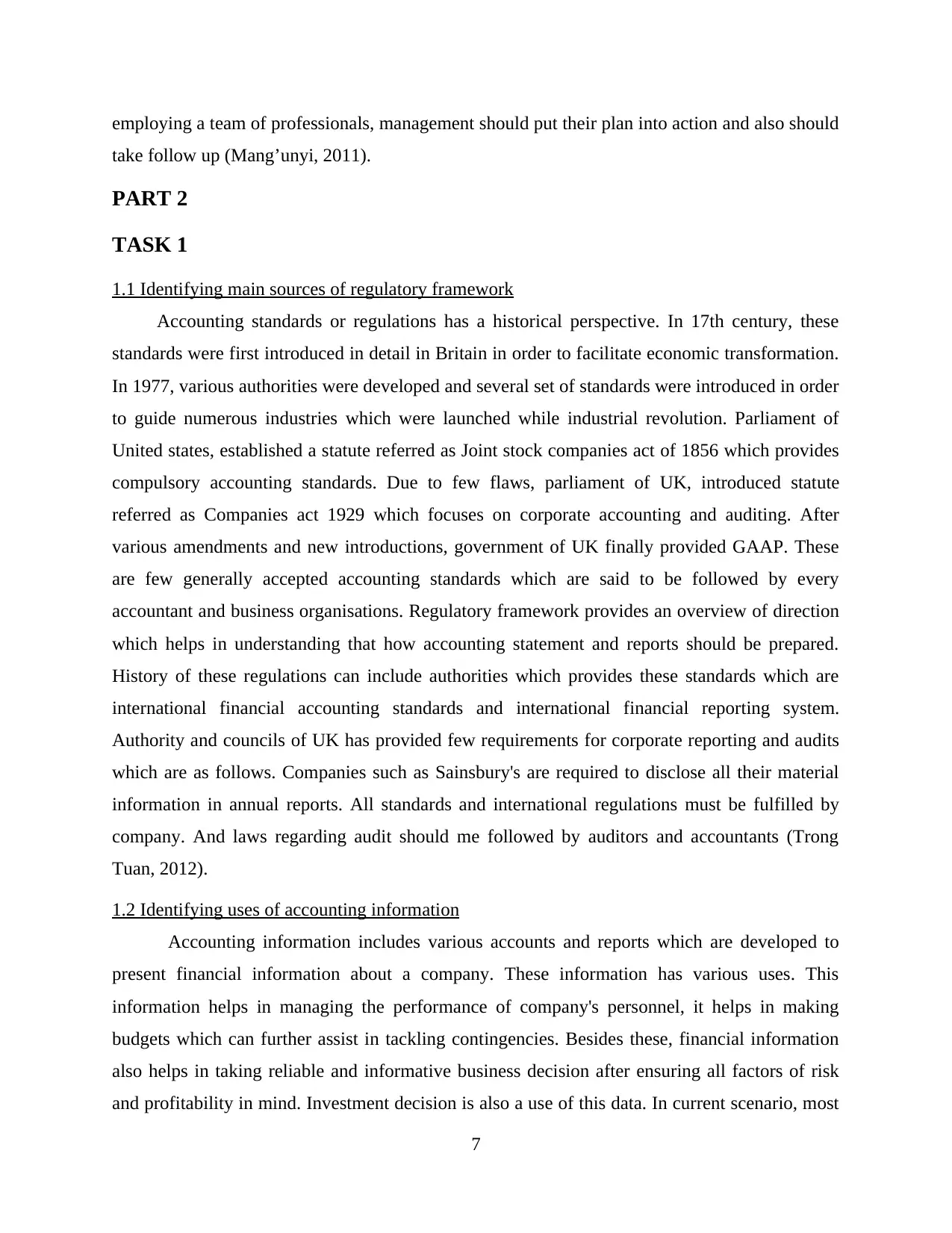
employing a team of professionals, management should put their plan into action and also should
take follow up (Mang’unyi, 2011).
PART 2
TASK 1
1.1 Identifying main sources of regulatory framework
Accounting standards or regulations has a historical perspective. In 17th century, these
standards were first introduced in detail in Britain in order to facilitate economic transformation.
In 1977, various authorities were developed and several set of standards were introduced in order
to guide numerous industries which were launched while industrial revolution. Parliament of
United states, established a statute referred as Joint stock companies act of 1856 which provides
compulsory accounting standards. Due to few flaws, parliament of UK, introduced statute
referred as Companies act 1929 which focuses on corporate accounting and auditing. After
various amendments and new introductions, government of UK finally provided GAAP. These
are few generally accepted accounting standards which are said to be followed by every
accountant and business organisations. Regulatory framework provides an overview of direction
which helps in understanding that how accounting statement and reports should be prepared.
History of these regulations can include authorities which provides these standards which are
international financial accounting standards and international financial reporting system.
Authority and councils of UK has provided few requirements for corporate reporting and audits
which are as follows. Companies such as Sainsbury's are required to disclose all their material
information in annual reports. All standards and international regulations must be fulfilled by
company. And laws regarding audit should me followed by auditors and accountants (Trong
Tuan, 2012).
1.2 Identifying uses of accounting information
Accounting information includes various accounts and reports which are developed to
present financial information about a company. These information has various uses. This
information helps in managing the performance of company's personnel, it helps in making
budgets which can further assist in tackling contingencies. Besides these, financial information
also helps in taking reliable and informative business decision after ensuring all factors of risk
and profitability in mind. Investment decision is also a use of this data. In current scenario, most
7
take follow up (Mang’unyi, 2011).
PART 2
TASK 1
1.1 Identifying main sources of regulatory framework
Accounting standards or regulations has a historical perspective. In 17th century, these
standards were first introduced in detail in Britain in order to facilitate economic transformation.
In 1977, various authorities were developed and several set of standards were introduced in order
to guide numerous industries which were launched while industrial revolution. Parliament of
United states, established a statute referred as Joint stock companies act of 1856 which provides
compulsory accounting standards. Due to few flaws, parliament of UK, introduced statute
referred as Companies act 1929 which focuses on corporate accounting and auditing. After
various amendments and new introductions, government of UK finally provided GAAP. These
are few generally accepted accounting standards which are said to be followed by every
accountant and business organisations. Regulatory framework provides an overview of direction
which helps in understanding that how accounting statement and reports should be prepared.
History of these regulations can include authorities which provides these standards which are
international financial accounting standards and international financial reporting system.
Authority and councils of UK has provided few requirements for corporate reporting and audits
which are as follows. Companies such as Sainsbury's are required to disclose all their material
information in annual reports. All standards and international regulations must be fulfilled by
company. And laws regarding audit should me followed by auditors and accountants (Trong
Tuan, 2012).
1.2 Identifying uses of accounting information
Accounting information includes various accounts and reports which are developed to
present financial information about a company. These information has various uses. This
information helps in managing the performance of company's personnel, it helps in making
budgets which can further assist in tackling contingencies. Besides these, financial information
also helps in taking reliable and informative business decision after ensuring all factors of risk
and profitability in mind. Investment decision is also a use of this data. In current scenario, most
7
Paraphrase This Document
Need a fresh take? Get an instant paraphrase of this document with our AI Paraphraser
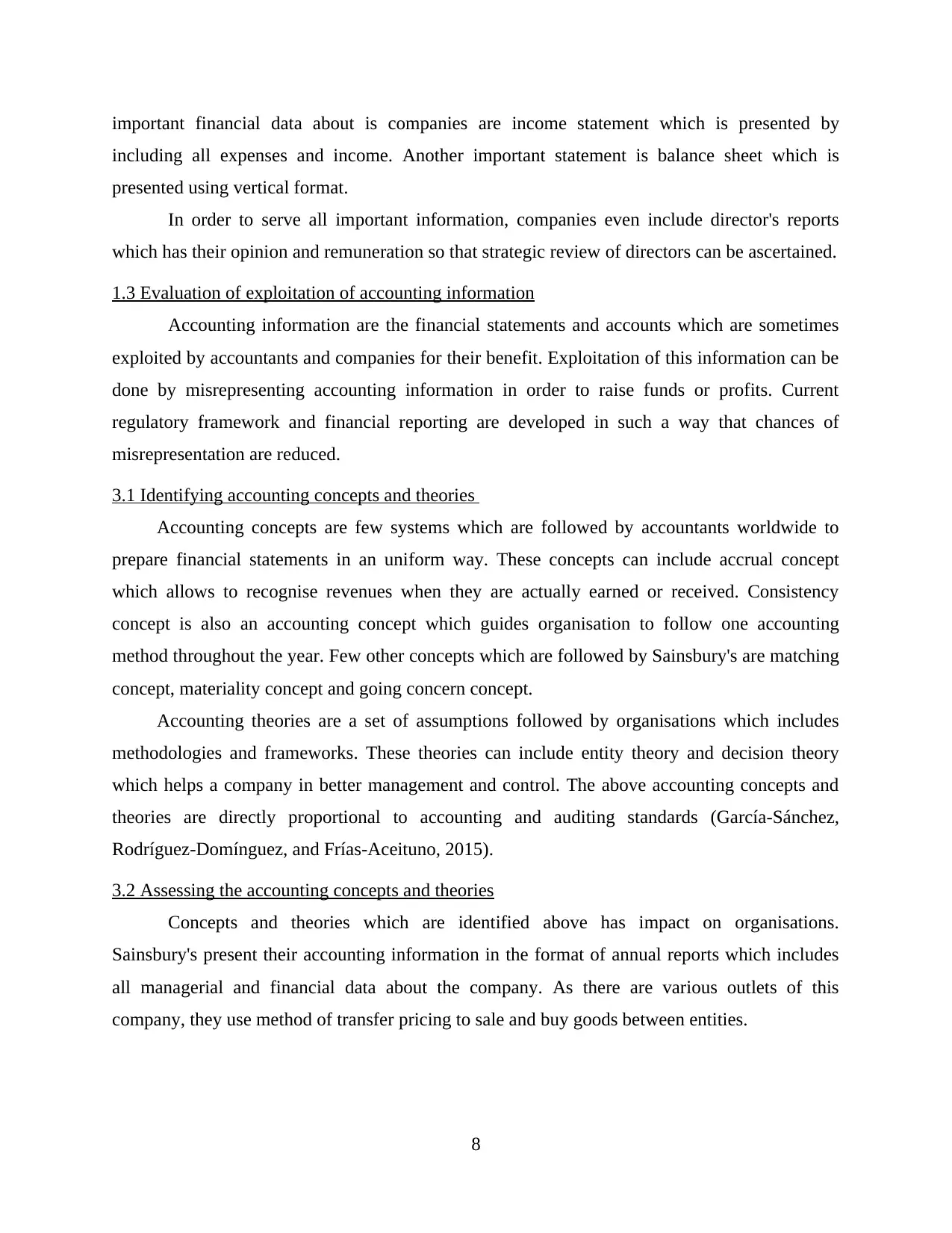
important financial data about is companies are income statement which is presented by
including all expenses and income. Another important statement is balance sheet which is
presented using vertical format.
In order to serve all important information, companies even include director's reports
which has their opinion and remuneration so that strategic review of directors can be ascertained.
1.3 Evaluation of exploitation of accounting information
Accounting information are the financial statements and accounts which are sometimes
exploited by accountants and companies for their benefit. Exploitation of this information can be
done by misrepresenting accounting information in order to raise funds or profits. Current
regulatory framework and financial reporting are developed in such a way that chances of
misrepresentation are reduced.
3.1 Identifying accounting concepts and theories
Accounting concepts are few systems which are followed by accountants worldwide to
prepare financial statements in an uniform way. These concepts can include accrual concept
which allows to recognise revenues when they are actually earned or received. Consistency
concept is also an accounting concept which guides organisation to follow one accounting
method throughout the year. Few other concepts which are followed by Sainsbury's are matching
concept, materiality concept and going concern concept.
Accounting theories are a set of assumptions followed by organisations which includes
methodologies and frameworks. These theories can include entity theory and decision theory
which helps a company in better management and control. The above accounting concepts and
theories are directly proportional to accounting and auditing standards (García-Sánchez,
Rodríguez-Domínguez, and Frías-Aceituno, 2015).
3.2 Assessing the accounting concepts and theories
Concepts and theories which are identified above has impact on organisations.
Sainsbury's present their accounting information in the format of annual reports which includes
all managerial and financial data about the company. As there are various outlets of this
company, they use method of transfer pricing to sale and buy goods between entities.
8
including all expenses and income. Another important statement is balance sheet which is
presented using vertical format.
In order to serve all important information, companies even include director's reports
which has their opinion and remuneration so that strategic review of directors can be ascertained.
1.3 Evaluation of exploitation of accounting information
Accounting information are the financial statements and accounts which are sometimes
exploited by accountants and companies for their benefit. Exploitation of this information can be
done by misrepresenting accounting information in order to raise funds or profits. Current
regulatory framework and financial reporting are developed in such a way that chances of
misrepresentation are reduced.
3.1 Identifying accounting concepts and theories
Accounting concepts are few systems which are followed by accountants worldwide to
prepare financial statements in an uniform way. These concepts can include accrual concept
which allows to recognise revenues when they are actually earned or received. Consistency
concept is also an accounting concept which guides organisation to follow one accounting
method throughout the year. Few other concepts which are followed by Sainsbury's are matching
concept, materiality concept and going concern concept.
Accounting theories are a set of assumptions followed by organisations which includes
methodologies and frameworks. These theories can include entity theory and decision theory
which helps a company in better management and control. The above accounting concepts and
theories are directly proportional to accounting and auditing standards (García-Sánchez,
Rodríguez-Domínguez, and Frías-Aceituno, 2015).
3.2 Assessing the accounting concepts and theories
Concepts and theories which are identified above has impact on organisations.
Sainsbury's present their accounting information in the format of annual reports which includes
all managerial and financial data about the company. As there are various outlets of this
company, they use method of transfer pricing to sale and buy goods between entities.
8
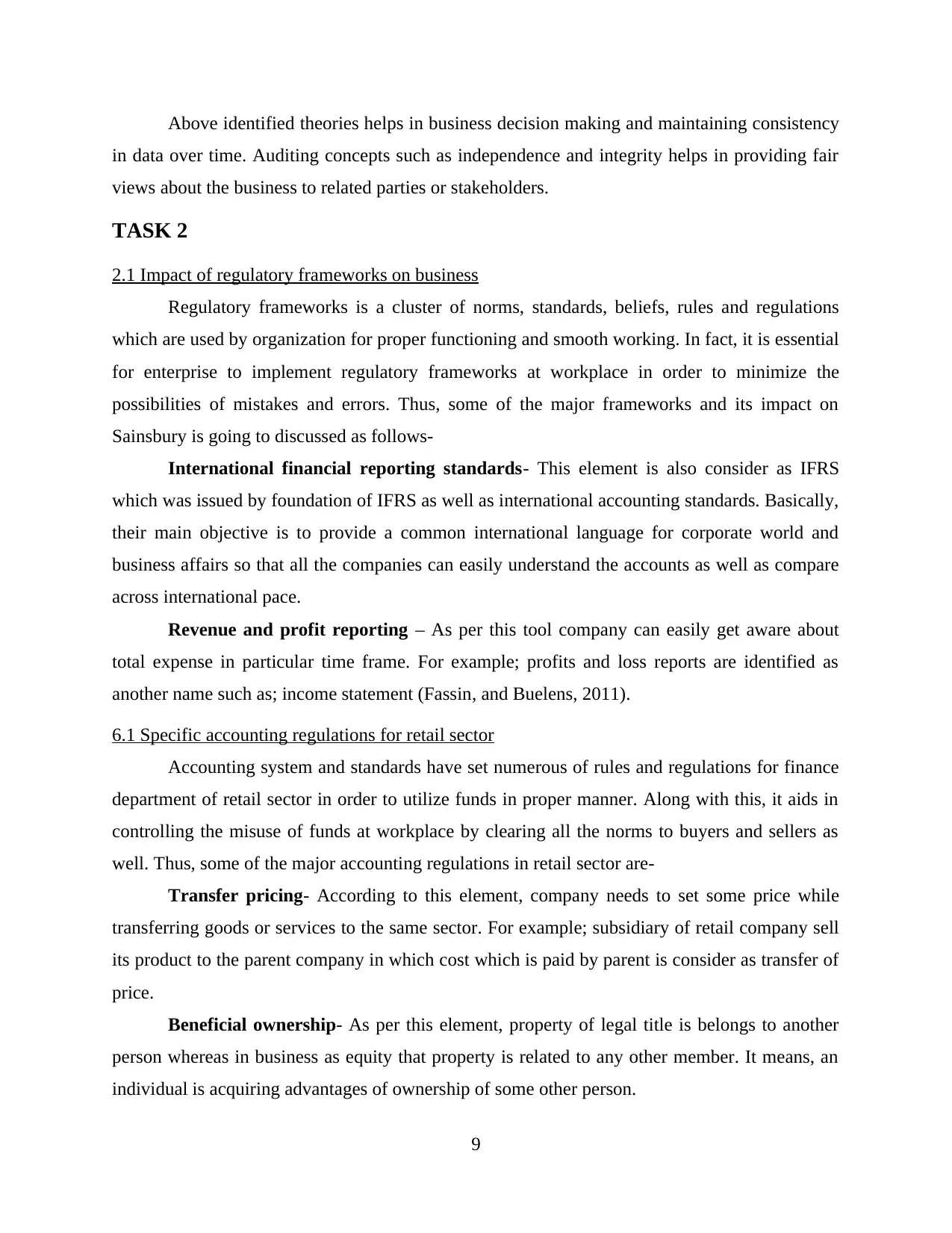
Above identified theories helps in business decision making and maintaining consistency
in data over time. Auditing concepts such as independence and integrity helps in providing fair
views about the business to related parties or stakeholders.
TASK 2
2.1 Impact of regulatory frameworks on business
Regulatory frameworks is a cluster of norms, standards, beliefs, rules and regulations
which are used by organization for proper functioning and smooth working. In fact, it is essential
for enterprise to implement regulatory frameworks at workplace in order to minimize the
possibilities of mistakes and errors. Thus, some of the major frameworks and its impact on
Sainsbury is going to discussed as follows-
International financial reporting standards- This element is also consider as IFRS
which was issued by foundation of IFRS as well as international accounting standards. Basically,
their main objective is to provide a common international language for corporate world and
business affairs so that all the companies can easily understand the accounts as well as compare
across international pace.
Revenue and profit reporting – As per this tool company can easily get aware about
total expense in particular time frame. For example; profits and loss reports are identified as
another name such as; income statement (Fassin, and Buelens, 2011).
6.1 Specific accounting regulations for retail sector
Accounting system and standards have set numerous of rules and regulations for finance
department of retail sector in order to utilize funds in proper manner. Along with this, it aids in
controlling the misuse of funds at workplace by clearing all the norms to buyers and sellers as
well. Thus, some of the major accounting regulations in retail sector are-
Transfer pricing- According to this element, company needs to set some price while
transferring goods or services to the same sector. For example; subsidiary of retail company sell
its product to the parent company in which cost which is paid by parent is consider as transfer of
price.
Beneficial ownership- As per this element, property of legal title is belongs to another
person whereas in business as equity that property is related to any other member. It means, an
individual is acquiring advantages of ownership of some other person.
9
in data over time. Auditing concepts such as independence and integrity helps in providing fair
views about the business to related parties or stakeholders.
TASK 2
2.1 Impact of regulatory frameworks on business
Regulatory frameworks is a cluster of norms, standards, beliefs, rules and regulations
which are used by organization for proper functioning and smooth working. In fact, it is essential
for enterprise to implement regulatory frameworks at workplace in order to minimize the
possibilities of mistakes and errors. Thus, some of the major frameworks and its impact on
Sainsbury is going to discussed as follows-
International financial reporting standards- This element is also consider as IFRS
which was issued by foundation of IFRS as well as international accounting standards. Basically,
their main objective is to provide a common international language for corporate world and
business affairs so that all the companies can easily understand the accounts as well as compare
across international pace.
Revenue and profit reporting – As per this tool company can easily get aware about
total expense in particular time frame. For example; profits and loss reports are identified as
another name such as; income statement (Fassin, and Buelens, 2011).
6.1 Specific accounting regulations for retail sector
Accounting system and standards have set numerous of rules and regulations for finance
department of retail sector in order to utilize funds in proper manner. Along with this, it aids in
controlling the misuse of funds at workplace by clearing all the norms to buyers and sellers as
well. Thus, some of the major accounting regulations in retail sector are-
Transfer pricing- According to this element, company needs to set some price while
transferring goods or services to the same sector. For example; subsidiary of retail company sell
its product to the parent company in which cost which is paid by parent is consider as transfer of
price.
Beneficial ownership- As per this element, property of legal title is belongs to another
person whereas in business as equity that property is related to any other member. It means, an
individual is acquiring advantages of ownership of some other person.
9
⊘ This is a preview!⊘
Do you want full access?
Subscribe today to unlock all pages.

Trusted by 1+ million students worldwide
1 out of 17
Related Documents
Your All-in-One AI-Powered Toolkit for Academic Success.
+13062052269
info@desklib.com
Available 24*7 on WhatsApp / Email
![[object Object]](/_next/static/media/star-bottom.7253800d.svg)
Unlock your academic potential
Copyright © 2020–2025 A2Z Services. All Rights Reserved. Developed and managed by ZUCOL.





